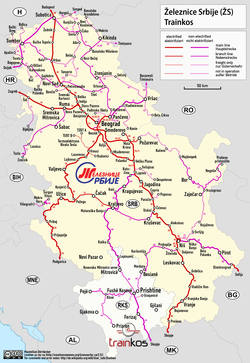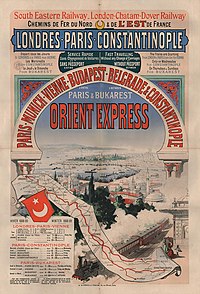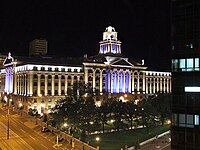Serbian Railways
 | |
Native name | Железнице Србије |
|---|---|
Romanized name | Železnice Srbije |
| Company type | State-owned enterprise |
| Industry | |
| Founded | 17 May 2005 (Current form) 1881 (Originally founded) |
| Headquarters | Nemanjina 6, Belgrade , |
Area served | Serbia |
Key people | Goran Adžić (General director) |
| Revenue | |
| Total assets | |
| Total equity | |
| Owner | Government of Serbia (56.43%) Serbian Development Fund (43.57%) |
Number of employees | 1,441 (2022) |
| Divisions | |
| Subsidiaries |
|
| Website | https://serbianrailways.com |
| Footnotes / references Business ID: 20038284 Tax ID: 103859991[4] | |
 Map of Serbian rail network | |
| Overview | |
|---|---|
| Locale | Serbia |
| Dates of operation | 1881–present |
| Technical | |
| Track gauge | 1,435 mm (4 ft 8+1⁄2 in) |
| Electrification | 25 kV AC, 50 Hz OHLE |
| Length | 3,739 km (2,323 mi)[5] |
Serbian Railways (Serbian: Железнице Србије, romanized: Železnice Srbije; abbr. ЖС or ŽS) is a Serbian engineering and technical consulting company based in Belgrade, Serbia.
In 2015, the Government of Serbia established three new companies which took over Serbian Railways' former jurisdictions: Srbijavoz (passenger transport), Srbija Kargo (cargo transport) and Serbian Railways Infrastructure (infrastructure management).
Since then, Serbian Railways continued with modified business activity: engineering and technical consulting, consulting activities in the field of information technology and other information technology services, buying and selling real estate, rental and management activities, accounting, bookkeeping and auditing activities, tax advisory services, technical testing and analysis, rental and leasing of other machinery, equipment of non-material goods, activities of the museums, galleries and collections.[6]
Serbia is a member of the International Union of Railways (UIC). The UIC Country Code for Serbia is 72.
History[edit]


Early history[edit]
The history of rail transport in Serbia began in the mid-19th century when most of the territory was still held by the Austro-Hungarian and Ottoman Empires. The first rail line on the present-day territory of Serbia was inaugurated on 20 August 1854, between Lisava-Oravica-Bazijaš and the train operated on horse-drawn traffic which was replaced in 1856 by steam locomotives. Part of the line is located in Serbia, passing through Bela Crkva while the rest is in Romania. All subsequently built lines were laid towards Budapest as the territory was still part of the Austro-Hungarian Empire back then. On the territory which was under the Ottomans, the line Skopje-Kosovska Mitrovica was inaugurated in 1874. However, the major expansion began after the Berlin Congress and the independence of the, theretofore vassal to the Ottomans, Principality of Serbia during the second half of the 19th century.[7]
Serbian Railways as a company is traced back to 1881 when Prince Milan I declared formation of the Serbian National Railways. The first train departed from Belgrade to Niš on 23 August 1884, which is considered by Serbian Railways as the official year when the company was created.[citation needed]
This was not the first operational railway on the territory of then-Kingdom of Serbia, though, as the one in opened in 1882, a primarily industrial, though occasionally used for passenger transport, 12 km long 600 mm wide gauge track from Majdanpek copper processing plant to Velike Livade (a former village taken over by the plant) and constructed by the Serbian Copper & Iron Co. (official name in English, most stockholders were British) had its first run on the track in June 1882.[8]
Another one in Eastern Serbia followed suit in 1888, the 82 km long dual purpose (industrial and passenger transport) 760 mm gauge track from Vrška Čuka mine to the port of Radujevac on the Danube, built by the Societé Anonyme "L'Industrielle Serbe" registered at Brussels in Belgian, French, (Austro-)Hungarian, and Serbian ownership (in order of the percentage of stock owned).[9][10]
From the 1920s until the 1990s, it operated under the name Yugoslav Railways, responsible for railways in the Socialist Federal Republic of Yugoslavia. The first electrified line was opened between Belgrade and Šid in 1970. The line connecting Serbia with south Adriatic (Belgrade-Bar) was opened in 1976.
1990–2015[edit]
During the 1990s, following the dissolution of the Socialist Federal Republic of Yugoslavia, railways in Serbia suffered the lack of maintenance of infrastructure and the level of traffic, especially cargo, decreased dramatically. As of 2000, Serbian Railways had a total of 32,832 employees. The negative trend continued into the 2000s. Better days for railways started in the early 2010s when program of modernization, both of infrastructure and rolling stock, have begun.
In 2013, Serbian Railways signed a contract with RZD International, worth $840 million, aimed at modernization of aging infrastructure by focusing on improving key sections of main railway lines. The section between Ruma and Golubinci on Belgrade-Šid line was reconstructed in 2014 and additional five sections on Belgrade-Niš-Preševo line (Sopot-Kosmajski Kovačevac, Mala Krsna-Velika Plana, Vinarce-Đorđevo, Vranjska Banja-Ristovac, and Bujanovac-Bukarevac) were modernized and revitalized in 2015 and 2016, while the section between Belgrade and Pančevo on Belgrade-Vršac line saw doubling tracks along with the reconstruction.[11]
2015–present[edit]
In March 2015, the Government of Serbia announced its plan to establish three additional new railway companies, splitting the Serbian Railways in separate businesses. Those companies are: Srbijavoz operating passenger transport, Srbija Kargo operating cargo transport and Serbian Railways Infrastructure operating as infrastructure management company.[12]
Those three companies, fully separated and independent from the Serbian Railways were founded on 10 August 2015, in the process of reconstruction and better optimization of business.[6] In the process, around 6,000 employees left the company with severance payments, which amounts to 39 million euros, by the end of 2017, thus cutting total number of employees from 17,635 in 2016 to around 11,500 in 2018, in all four rail related companies combined.[13] From 2018 to 2020, in the third wave of dismissals, another 1,500 employees are planned to leave the company, cutting the total number of employees to around 10,000 by 2020.[14] That would be 7,635 less employees (43.29%) than in 2016, and 22,800 less (69.51%) than in 2000.[14]
Current modernization projects[edit]
In February 2019, Srbijavoz temporarily suspended transportation on Belgrade–Novi Sad railway, one of the country’s most frequent passenger routes, in February 2022, due to the railway line’s reconstruction.[15] This line in now completely reconstructed and modernized and the Fast trains - named "SOKO" are going up to 200 km/h, connecting two biggest cities in 36 minutes. The route is 75 km long and its reconstruction is currently extended from Novi Sad to Subotica, (border with Hungary) for the speed of 200 km/h as part of the modernization of the Belgrade-Budapest railway line.[16]
The reconstruction and modernization of the railway lines is also planned between Belgrade and Niš for a speed of 200 km/h,[17] Niš and Preševo for the speed of 160 km/h (border with North Macedonia)[18] and Niš and Dimitrovgrad for the speed of 120 km/h(border with Bulgaria).[19]
In 2017, as part of the contract with RZD, reconstruction began on the Belgrade-Novi Sad-Subotica line, on the section between Stara Pazova and Novi Sad, Belgrade-Bar line, on the section between Resnik on the outskirts of Belgrade, and Valjevo.[20][21]
New investments in rolling stock took place in the following years. Around 60 new passenger trains (39 diesel multiple units RA2 from the Russian company Metrovagonmash and 21 electric multiple units FLIRT3 from Swiss company Stadler) were ordered and are currently in service.[22][23] Because of this, passenger numbers dramatically raise on the lines operated by the new trains.
Passenger transport[edit]

Srbijavoz inherited the passenger transport from the Serbian Railways following the establishment. Since 2015, it offers many train services across the country and in the region which include international routes to neighbouring countries and domestic routes (fast, regional and local lines).
It is possible to buy passengers tickets online throughout Srbijavoz website: https://webapi1.srbvoz.rs/ekarta/app/#!/home. The company also offer the mobile application for Android (https://play.google.com/store/apps/details?id=com.srbijavoz.app) and IOS (https://apps.apple.com/rs/app/srbija-voz/id1600735042) operating systems.
The Serbian railway system consists of 3,739 km of rails of which 295 km is double track (7.9% of the network). Some 1,279 km of track (33.6% of the network) is electrified.[5] Serbia has rail links with all of adjacent countries, except Albania.
Domestic railway network[edit]
Railroads are categorized as "main lines", "regional lines", "local lines" or "manipulative lines". Following is the table of main lines in Serbia:
| No. | Route | Length | Tracks | Electrification | Notes |
|---|---|---|---|---|---|
| 1 | Belgrade – Ruma – Border with Croatia near Šid | 120 km | 2 | yes | It is shared track between Belgrade and Stara Pazova with Railway line 4. |
| 2 | Belgrade – Niš – Border with North Macedonia near Preševo | 398 km | 1/2 | yes | Two tracks are between Velika Plana and Stalać as well as between Đunis and Niš. Modernization and reconstruction is planned to start in 2023 up to high-speed rail of maximum 200 km/h between Belgrade and Niš. |
| 3 | Belgrade – Mala Krsna – Velika Plana | 102 km | 1 | yes | |
| 4 | Belgrade – Novi Sad – Border with Hungary near Subotica | 183 km | 2 | yes | High-speed (200 km/h) rail is opened between Belgrade and Novi Sad since 19.03.2022. Double tracking and upgrade to high-speed of 200 km/h is currently in progress from Novi Sad to Subotica (border with Hungary). |
| 5 | Niš – Border with Bulgaria near Dimitrovgrad | 104 km | 1 | no | Reconstruction, electrification and modernization started on November 2023 and will last next tree and a half years for the maximum speed of 120 km/h.[24] |
| 6 | Belgrade – Pančevo – Border with Romania near Vršac | 102 km | 1/2 | partially | There are 2 tracks that are electrified between Belgrade and Pančevo. |
| 7 | Belgrade – Valjevo – Užice – Border with Montenegro near Prijepolje | 299 km | 1 | yes | |
| 8 | Lapovo – Kragujevac – Kraljevo – Administrative line with Kosovo & Metohija near Rudnica | 153 km | 1 | no | |
| 9 | Subotica – Sombor – Border with Croatia near Bogojevo | 87 km | 1 | no |
International railway network[edit]
As of 2023 Srbijavoz's only international passenger line is the Belgrade-Bar line going to Montenegro.
The international connections to Croatia, Romania, North Macedonia and Bulgaria are currently freight only.
Since November 2023, passengers can connect from ZS services at Subotica to a MÁV service for Szeged. [25]
Rolling stock[edit]



- Electric locomotives
- Diesel locomotives
- ŽS 621 with total of: 17 units (N/A in service)
- ŽS 622 with total of: 4 units in total (4 in service)
- ŽS 641 with total of: 37 units (11 in service)
- ŽS 644 with total of: 6 units (2 in service)
- ŽS 661 with total of: 42 units (23 in service)
- ŽS 664 with total of: 6 units on lease from Slovenian Railways
- ŽS 666 with total of: 4 units (2 in service)
- Electric trainsets
- Diesel trainsets
- ŽS 711 with total of: 39 units (39 in service)
- Passenger carriages
- Passenger cars - "open" or "compartment" with total of: 364 units
- Sleeping cars with total of: 52 units
- Couchette cars with total of: 63 units
- Dining cars. with total of: 15 units
See also[edit]
References[edit]
- ^ "КОНСОЛИДОВАНИ БИЛАНС УСПЕХА (2022) – Serbian Railways". apr.gov.rs (in Serbian). Retrieved 16 November 2023.
- ^ "КОНСОЛИДОВАНИ БИЛАНС УСПЕХА (2018) – Serbian Railways". apr.gov.rs (in Serbian). Retrieved 29 August 2019.
- ^ a b "КОНСОЛИДОВАНИ БИЛАНС СТАЊА (2022) – Serbian Railways". apr.gov.rs (in Serbian). Retrieved 16 November 2023.
- ^ "Основни подаци о привредном друштву". apr.gov.rs (in Serbian). Serbian Business Registers Agency. Retrieved 28 February 2018.
- ^ a b http://www.parlament.rs/upload/archive/files/cir/pdf/akta_procedura/2017/859-17.pdf [bare URL PDF]
- ^ a b "General Information". serbianrailways.com. Serbian Railways. Retrieved 14 October 2019.
- ^ History Archived 22 November 2012 at the Wayback Machine at Serbian Railways official website
- ^ Reference in Serbian
- ^ Reference in Serbian
- ^ Reference in Serbian with a French introduction and abstract
- ^ "Ekonomski pregled RS".
- ^ "Železnice će imati četiri preduzeća od 1. jula". blic.rs (in Serbian). Blic. Tanjug. 17 March 2015. Retrieved 12 January 2018.
- ^ Gedošević, Lana (23 August 2016). "Šta čeka 2.000 ljudi kojima se sprema otkaz u "Železnicama Srbije"". blic.rs (in Serbian). Retrieved 12 January 2018.
- ^ a b Vukašinović, Slađana (15 December 2017). ""Železnice" otpuštaju 2.500 ljudi DO KRAJA GODINE". blic.rs (in Serbian). Retrieved 12 January 2018.
- ^ "REKONSTRUKCIJA PRUGE Vozom od Beograda do Novog Sada TEK OD 2022". blic.rs (in Serbian). 1 February 2019. Retrieved 5 October 2019.
- ^ "Brza pruga ka Subotici: Intenzivni građevinski radovi u Novom Sadu zabeleženi iz drona (Video)". 31 October 2022.
- ^ "Ugovor za brzu prugu Beograd - Niš biće potpisan 22. Decembra, najavio Mali".
- ^ "Stižu brzi vozovi i u Bujanovac, najavljena i rekonstrukcija pruge Niš - Preševo". 22 July 2022.
- ^ "Meђународне набавке – "Инфраструктура железнице Србије" ад".
- ^ "Potpisan ugovor za prugu Stara Pazova – Novi Sad".
- ^ "ŽELEZNICE SRBIJE - Vest". Archived from the original on 10 June 2017. Retrieved 8 June 2017.
- ^ "Serbian Railways buys 21 trains from Swiss company". 3 April 2013.
- ^ "Novi ruski vozovi pušteni u saobraćaj".
- ^ https://europa.rs/railway-nis-dimitrovgrad-modernisation-for-speeds-of-up-to-120-km-h/?lang=en
- ^ "Passenger traffic on Hungary-Serbia railway section resumes after 8-yr hiatus".


 French
French Deutsch
Deutsch